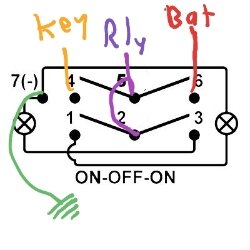No issues. it doesnt care if there is no current running through it.
yep its that simple. that is exactly correct.
all of the stuff i have connected to my "accessory bus" are just signals with near 0 amperage - such as remote wire for amp, BT receiver, USB charger, etc... Everything you could power off of the accessory plug (cigarette lighter) without overloading that circuit.
and remember, even though its drawn as a bar in the diagram, i used one of these as the "accessory bus"
Amazon.com : wago lever nut
its just a convenient place to attach a bunch of wires. the wago lever nut is like a wire nut but for more than just 2-3 wires.
for the DPDT
first - i am pretty sure you have the wrong switch for this - but dont worry, you have the wrong switch for your winch too and it will work out... kind of
this is the switch you need for the accessory power
OTRATTW - the Switch Guys Carling Technologies V-Series switches
the difference is in the detent. the one you have will spring back to the neutral position (everything off) when you let go of it.
however this is exactly what you want to operate the winch.
so for the main DPDT switch:
i stole this from
@TripleB's post in the other thread
@TripleB did it better than i did. mine is wired different than this but it still works. i will probably convert mine to this later.
View attachment 207894
Green is negative. Red to your 2nd battery. Yellow from key on power source. Purple to your relay/stinger.
for your winch, you just follow the diagram you have. just attach the battery to the solenoid instead of directly to the winch like i have in my diagram. then wire the solenoid to the winch as shown.
OK so you will need to use the DPDT switch you already bought to do this. the switch you have for the winch wont work. you can keep it for later and just swap out the rocker when you put in another accessory. that switch can be used to turn something on / off. the winch switch has to be on (in) / off / on (out) and spring back to center.
just remove the factory rocker from the harness if its already wired up to the solenoid.
if i am reading the winch diagram right there is a black, red, and green wire coming out of the back of the switch.
use another wire from your accessory bus and connect to pins 2 and 5.
wire the black and green to 1 and 3
connect 7 to ground (for the lights in the switch)
View attachment 207892
wire the green and black to the solenoid like the diagram shows.
you will also need to connect from your accessory bus to the red wire on the hand held remote plug for it to work. wire it as shown in the diagram.
if the winch operates backwards you can swap the wires at the back of the switch or on the solenoid
see above
and yes # 7 can go to neg bus bar or any ground connection



